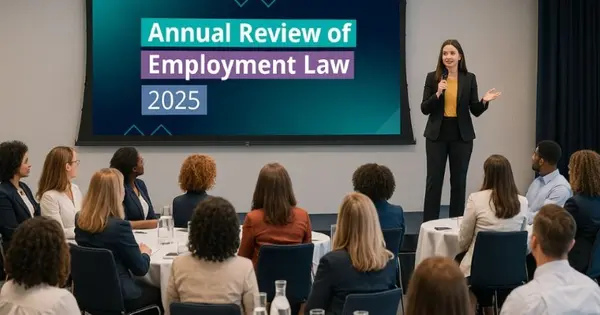Seamus McGranaghan qualified as a Solicitor in O'Reilly Stewart Solicitors in 2003 and is an experienced Commercial Lawyer dealing with employment, commercial and education cases.
He has experience in the Industrial Tribunal representing both Claimants and Respondents and has provided seminars in relation to particular areas of employment law. Seamus is the only member of the Education and Law Association in Northern Ireland. He specialises in advising schools and colleges on policy matters, employment issues and student welfare. He is also responsible for the Education Law Quarterly Review.
In addition to having contributed at Legal Island’s Education Updates since 2010, Seamus in association with Legal Island provides a live “Employment Law @ 11” webinar on the first Friday of each month, dealing with all aspects of Employment law affecting Northern Irish employers.
I've been working from home throughout the pandemic and I'd have to say it has definitely had an impact on me. I mean, my step count is seriously reduced. I have a lot of bad habits sitting at my desk, slouching. I did have a workplace assessment when I started at Legal-Island, but I must admit that I just . . . I find I sit for long periods of time. I stare into my computer, back-to-back things, meetings, and I'm sure I'm not the only one. So why is a workplace assessment while people are working from home still so important?
Stuart: Well, first of all, compliance. The Health and Safety Executive last year came very much off the fence and said anybody who is working from home, even temporarily during the pandemic, has the same rights and the same need for protection from the employer as they did if they were in the office. So that's the first one.
The second one is if you get a claim coming down the line in five years' time, and at the moment you haven't got a Scooby Doo what they're doing at home, whether they're working from bed or working from the settee, how are you going to defend it or what can you do? So really, you do need to understand what the person's working circumstances are.
But this leaves a bit of a problem, because if you look at the HSE's own tool for DSE assessments, that was written in 2002. And if you think what computers looked like in 2002, they were deeper than they were wide. And clearly, the regs didn't talk about . . . Well, they kind of touched on smartphones, but they didn't really see smartphones being what they are now. And they certainly didn't see the advent of homeworking.
So you've got to look at . . . If you just put out the questionnaire as free from the Health and Safety Executive, you're kind of missing the point, because it's not totally fit for purpose, and the HSE will be the first ones to agree with that. They're looking at it and going to be reviewing it in 2025. The delay is after that B word, which we can't mention.
So you need to be looking at not only the basic, "Well, what is a desk, chair, and things like that?" But you also need to be looking at the mental health, and you need to be looking at the culture and people's work behaviours at home, because unless they're right, you're really missing the point.
One of the other problems we've got, of course, is what is reasonably practicable. So in other words, if you've got several . . . An example I can think of, a London-based, two-bedroom flat in Canary Wharf, two couples working for the same company. We got asked to get involved because they were all struggling. And they were four of them working around a small bistro table with four chairs, their laptops. It must have been hell. There was no room for anything. So could you put office tables and chairs into that flat? No.
Those people were desperate to get back into the office, which is the counter to what, of course, you were saying, Seamus, with people wanting to stay at home working. There's a good percentage of people out there, according to the surveys, who are desperate to come back to work. They tend to be the younger millennials, of course, who are desperate, the juniors. All the senior managers want to stay at home, and that itself is a problem.
So what we need to be thinking about is what is reasonably practical as an adjustment. Many companies are taking different views on that term in our view. Some are going, "La, la, la. We don't want to know", right through to some are saying, "Whatever you want you can have". That variance is enormous at the moment. And I can't see any standardisation in what is acceptable to be offering and certainly from the equipment perspective how to deal with that.
Christine: And just with regards homework and equipment, is the company required to provide stuff like internet security, a desk, a chair that adjusts, all of that stuff? Does the company have to pay for that?
Stuart: In theory, yes, because the compliance is the same for at home as it is in the office. But the practicality of that situation . . . Go back to the people sitting in that studio flat. You can't do it. It's not reasonably practicable to put four desks and office chairs and computers into that room. So if they want to continue working in that circumstance or . . .
I can think of another case where a lady decided that she had to sit on the settee all day to work. We've come across people who say they've got to work from bed because there's no room to move around in their homes. So is that reasonably practicable?
To my knowledge, there's no case law on this yet. I'll defer to you if you tell me otherwise. There's nothing out there to actually say, "Is that reasonable or isn't it reasonable?"
My view, working from bed or a settee is not reasonable because it's going to lead to poor postures working, which are going to have a cumulative effect, and down the line, you're going to have problems with RSI and potential issues occurring that are defined as work-related issues. They're in the pipeline coming at us in the next few years with people who are working in poor postures day in day out that are working from home.
So I think we're going to try and guard against that and encourage people to work in good postures. But can you make somebody who's working from home or is sat on their settee come into the office? Is that a reason legally enough to say, "No, you can't do it"? That's an interesting new question, and I haven't got the answer.
Christine: Yeah. Seamus, what would your view be on that? Legally speaking, is that a fair enough point to say, "Sorry, we're concerned about your well-being at home. You can't work from home"?
Seamus: I mean, the key thing then is the risk assessment that is done. And absolutely, because we know that the employer has a duty of care and a duty to look after the welfare of their employee. If there are circumstances where the employee can't facilitate a remote working or working from home, or to a point where the employee is going to injure themselves or cause themselves harm, the employer certainly can't condone that. And if the employer did and didn't take any steps in relation to it, the likelihood is that the employee would stand to take an action against the employer and that they may well be successful. So I agree absolutely.
Stuart: Yep.
Christine: Yeah. I suppose it comes down to the communication. Communication, again, seems to be key, doesn't it?
Stuart, what would your top tips be for a healthy working-from-home environment then?
Stuart: Look at the evidence. The evidence is tying down to sedentary working. The UK government are very much keen on this idea of obesity pandemic is the next pandemic we're getting. The best survey I've seen is saying everybody in the UK has put on at least four pounds since the pandemic. As a clinical physiotherapist, you can ask the question to somebody, "How much weight have you put on since the pandemic started?" Because you know the answer is going to be in the affirmative. They have. Virtually 80% I reckon.
It's all about active working. It's all about getting people off their bottoms and moving. You look at the best practice guidelines, the best stuff is coming out of the States by a long way. From Cornell University, probably the biggest hotbed of ergonomics in the world, they talk about for every half an hour of work that you should be getting up and moving around for about 10 minutes of that half an hour. Now, that's a big chunk of time.
Christine: It is, yeah.
Stuart: If you look at Public Health England's guidelines, they talk about getting up and moving around for two hours in an eight-hour sedentary working shift and aiming to be on your feet for four hours. Again, that's a big ask, but that's been there since 2016 as a guideline. It's kind of one of those that sneaked out and nobody took any notice of, but it's very much there on the statute, and there's very strong evidence behind it.
This is the problem, linking back to the government's idea of pandemic, because we know the increase in sedentary working leads to diabetes, heart disease, to strokes. The cost of the public purse of diabetes alone goes into the billions. So it's a case of the whole of the drive is to get a healthier population in the UK.
Homeworking is a massive, fantastic opportunity to get people off their bottoms and stand up and move around. How many people listening to this call actually have stood up so far in this meeting just to move around and just loosen off and get active?
Reality is that's what you should be doing, but it's changing the work culture. So your boss is talking to you, "La, la, la", and you're sitting there dutifully going, "Yes, yes, yes". What's stopping you standing up and just stepping away from the screen for a second and just standing there and listening in standing? What's the cultural barrier that's stopping that? It's just not what we're used to, right?
It's what we've got to get used to if we're going to start reaching the guidelines for active working that have been set for us and are highly evidence-based to say it's the correct thing to do.
So the top tip is to get moving. Get moving. Long work in our culture is we're coming across people working crazy hours and wondering why their back hurts. It's because they're sitting down for 15 hours a day at their desk. Is it acceptable? How much should management be controlling that rather than just accepting and thinking, "I'm getting more pound for my flesh for them working a 15-hour day instead of an 8-hour day"?
The evidence behind lunch breaks is enormous, around productivity. If you go to somewhere like Toyota in Derby, they are very much Kaizen thinking, and part of that is the idea of if you get up and move away at lunchtime from your work, you come back fresh. If you come back fresh, you're actually more productive. And the evidence suggests that you're actually more productive by 5:00 than you would have been if you worked through your lunch.
So taking lunch breaks is . . . It began a bit of a cultural issue. Why do people say, "I'm too busy to take my lunch"? Well, hang on a minute. If you take a break, you come back fresher and you work faster. So you're not achieving anything, and in fact, you're damaging your health.
So taking lunch breaks and getting buddy groups up and actually working with people to actually realise the importance of taking lunch breaks is absolutely essential.
Communication is the last one. It's all about how do you actually get these messages through and how do you change cultures to actually get people to start getting up and moving around, thinking differently about how they work, getting light and air into their rooms, and getting all the other things and all these communications and key messages? How do you do it? Lots of imaginative ways coming through now, but I think the key one is leadership. Actually getting your manager to disseminate it down, "Well, I'm doing this. Why aren't you?" to me, is the most potent and powerful one of the lot.
Christine: And how involved should employers get with helping a worker plan where and how they're going to work from home?
Stuart: Well, that one is "How long is a piece of string?" question, isn't it? It's a case of how much should they be involved. If somebody is working from home, it is their home at the end of the day. You can educate, and if that education is documented, is the duty of care done? In my view, probably. If somebody is working from home doing their own thing, the education process and you've effectively signed off to say, "Yes, this is what they should be doing", that to me is where we should be.
If we go much further, are we ending up in Big Brother? That's kind of where I am. And that's dangerous territory for any society. But where that borderline is between Winston being watched all day and being allowed the freedom and flex and . . . There's a lot of evidence behind if you give people a choice and ability to do things, they are more productive. It's a very fine line between the two, and where that balance is I couldn't tell you precisely.
Christine: Brilliant. Thank you for that. Let's just see if we've got any questions coming in. I think we've covered the questions. Has anyone got any kind of takeaway they'd like to add just before we begin wrapping things up?
Seamus: Maybe just from the legal perspective. On the basis of the poll, definitely I think we need to look at getting a policy in place for hybrid working. And again, I think for me really it is just about organisations doing the assessment, deciding what roles can and can't be worked on a hybrid basis, and being fair and consistent then in relation to their approach.
Obviously, the other thing that was important to mention was just in relation to reasonable adjustments and whether or not if somebody has a disability and they make an application for a reasonable adjustment. That's maybe on of the things that can be considered, would be the hybrid working, just to mention that. But other than that, I'll leave it to Stuart then to . . .
Stuart: So, to me, it's education. It's culture. And if you're going to provide furniture, one of the key things that keeps coming back to us is, "Well, does it fit in with my home?" That keeps coming back, and I kind of get it. It's got to be aesthetically right if it's going to sit in your dining room or your living room where you're going to spend the rest of your life.
My view on this is it's dangerous to say to people, "Hey, here's £500 or whatever. Go and buy your own furniture". Because you've got no control on how good the ergonomics of that furniture is. I think you're better off actually working with a company, any company who's involved in ergonomics and office furniture, and actually agreeing on a set span of equipment that is approved.
Now, the advantage for the employer is the fact that you know what's going into the house, and what is effectively work equipment. The advantage for the employee is, of course, if it's done right as a deal, they'll get very, very strongly commercial rates on pricing because it's highly discounted.
Office furniture is a massively discounted marketed. So if you go and buy one chair, you'll pay RRP. If you go and buy 100 chairs, you'll get a 30%, 40% discount. So it's a case of bulk buying, but actually for individuals. It does work. And I'd encourage people to look at that as option. But it gives the employer control at the end of the day, and that's really important so you know what people are doing and what they are sitting on and is it suitable.
Continue reading
We help hundreds of people like you understand how the latest changes in employment law impact your business.
Please log in to view the full article.
What you'll get:
- Help understand the ramifications of each important case from NI, GB and Europe
- Ensure your organisation's policies and procedures are fully compliant with NI law
- 24/7 access to all the content in the Legal Island Vault for research case law and HR issues
- Receive free preliminary advice on workplace issues from the employment team
Already a subscriber? Log in now or start a free trial



